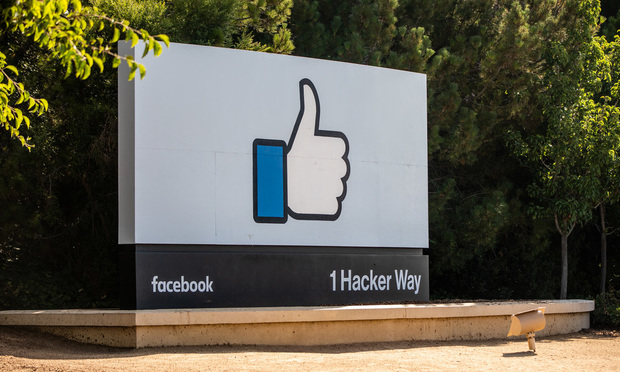Facebook Expands AI Translation Tools to Increase Its Global Content Moderation
Facebook aims to take a "no language left behind" approach to moderating content posted on its social media platform.
September 12, 2018 at 03:27 PM
3 minute read
 A giant thumbs-up button marks the entrance to the Facebook campus, located at 1601 Willow Rd. in Menlo Park, California. Photo credit: Jason Doiy/ALM
A giant thumbs-up button marks the entrance to the Facebook campus, located at 1601 Willow Rd. in Menlo Park, California. Photo credit: Jason Doiy/ALM
Facebook took another step to reduce hate speech on its global platform this week, announcing an expansion of its artificial intelligence translation tools.
While the company's platform content moderation policies—toward both hate speech and fake news—have come under scrutiny in the U.S., Facebook's decisions on which posts come down can be even more complicated in non-English-speaking countries.
If content moderators can't read a post's language, it's hard (if not impossible) to spot hate speech. That issue was raised again last month after Menlo Park, California-based Facebook booted, for the first time, a senior government official off the platform for violence-inducing hate speech in Myanmar.
“When we factor in the number of languages in use and the volume of content on those platforms, we are serving nearly 6 billion translations per day to our community. Using traditional methods, it could take years to professionally translate a single day's content,” a Facebook blog post announcing the translation tool expansion said.
The Menlo Park, California-based company said translating more content into more languages will help moderators detect hateful and policy-violating posts on the platform. Facebook said it has added 24 new languages, including Serbian, Punjabi and Cambodian, to its automatic translation services, with a total of 4,504 language direction translations now offered online.
But many of these language translations are still at an early stage, the company said, and not of professional quality yet. Facebook noted that, for translation AI to properly translate every post, there needs to be an extensive data set of correct translations between the two languages involved.
For many languages, there is no extensive translation data set, which makes it difficult to train tools quickly. To solve this issue, the company has increased its labeling of Facebook posts in needed languages, then had them automatically translated, to produce examples for the tools.
Facebook also analyzed pages that have been manually translated by a user, for example, a business that offers the same information online in both English and Cambodian, to create data examples. If a language Facebook already translates into English is similar to one the company hasn't translated yet, those similarities can be used to better understand a post's meaning as well.
On Tuesday, Facebook said it's long-term goal was to have “no language left behind.”
“That means improving the quality of translations in all languages, moving beyond just useful and toward highly accurate, fluent, and more human-sounding translations. In the longer term, it also means expanding our supported directions to cover all languages used on Facebook,” the company said.
This content has been archived. It is available through our partners, LexisNexis® and Bloomberg Law.
To view this content, please continue to their sites.
Not a Lexis Subscriber?
Subscribe Now
Not a Bloomberg Law Subscriber?
Subscribe Now
NOT FOR REPRINT
© 2025 ALM Global, LLC, All Rights Reserved. Request academic re-use from www.copyright.com. All other uses, submit a request to [email protected]. For more information visit Asset & Logo Licensing.
You Might Like
View All
FTC Sues PepsiCo for Alleged Price Break to Big-Box Retailer, Incurs Holyoak's Wrath
5 minute read
Wells Fargo and Bank of America Agree to Pay Combined $60 Million to Settle SEC Probe

‘Extremely Disturbing’: AI Firms Face Class Action by ‘Taskers’ Exposed to Traumatic Content
5 minute read
MLB's Texas Rangers Search for a New GC and a Broadcasting Deal
Trending Stories
Who Got The Work
J. Brugh Lower of Gibbons has entered an appearance for industrial equipment supplier Devco Corporation in a pending trademark infringement lawsuit. The suit, accusing the defendant of selling knock-off Graco products, was filed Dec. 18 in New Jersey District Court by Rivkin Radler on behalf of Graco Inc. and Graco Minnesota. The case, assigned to U.S. District Judge Zahid N. Quraishi, is 3:24-cv-11294, Graco Inc. et al v. Devco Corporation.
Who Got The Work
Rebecca Maller-Stein and Kent A. Yalowitz of Arnold & Porter Kaye Scholer have entered their appearances for Hanaco Venture Capital and its executives, Lior Prosor and David Frankel, in a pending securities lawsuit. The action, filed on Dec. 24 in New York Southern District Court by Zell, Aron & Co. on behalf of Goldeneye Advisors, accuses the defendants of negligently and fraudulently managing the plaintiff's $1 million investment. The case, assigned to U.S. District Judge Vernon S. Broderick, is 1:24-cv-09918, Goldeneye Advisors, LLC v. Hanaco Venture Capital, Ltd. et al.
Who Got The Work
Attorneys from A&O Shearman has stepped in as defense counsel for Toronto-Dominion Bank and other defendants in a pending securities class action. The suit, filed Dec. 11 in New York Southern District Court by Bleichmar Fonti & Auld, accuses the defendants of concealing the bank's 'pervasive' deficiencies in regards to its compliance with the Bank Secrecy Act and the quality of its anti-money laundering controls. The case, assigned to U.S. District Judge Arun Subramanian, is 1:24-cv-09445, Gonzalez v. The Toronto-Dominion Bank et al.
Who Got The Work
Crown Castle International, a Pennsylvania company providing shared communications infrastructure, has turned to Luke D. Wolf of Gordon Rees Scully Mansukhani to fend off a pending breach-of-contract lawsuit. The court action, filed Nov. 25 in Michigan Eastern District Court by Hooper Hathaway PC on behalf of The Town Residences LLC, accuses Crown Castle of failing to transfer approximately $30,000 in utility payments from T-Mobile in breach of a roof-top lease and assignment agreement. The case, assigned to U.S. District Judge Susan K. Declercq, is 2:24-cv-13131, The Town Residences LLC v. T-Mobile US, Inc. et al.
Who Got The Work
Wilfred P. Coronato and Daniel M. Schwartz of McCarter & English have stepped in as defense counsel to Electrolux Home Products Inc. in a pending product liability lawsuit. The court action, filed Nov. 26 in New York Eastern District Court by Poulos Lopiccolo PC and Nagel Rice LLP on behalf of David Stern, alleges that the defendant's refrigerators’ drawers and shelving repeatedly break and fall apart within months after purchase. The case, assigned to U.S. District Judge Joan M. Azrack, is 2:24-cv-08204, Stern v. Electrolux Home Products, Inc.
Featured Firms
Law Offices of Gary Martin Hays & Associates, P.C.
(470) 294-1674
Law Offices of Mark E. Salomone
(857) 444-6468
Smith & Hassler
(713) 739-1250






